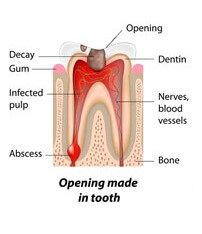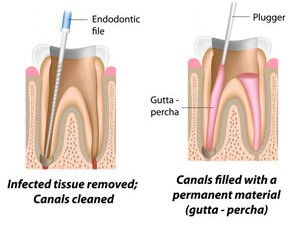Root Canal Treatment
Root Canal Treatment
Root canal treatment, also known as Endodontics is a type of dentistry that manages the dental pulp and its supporting structures. The dentist aim is to preserve a tooth in function especially when the cost of tooth loss and replacement is much greater.
Before starting treatment, the dentist will first make sure that you will not feel any pain by using very effective local anaesthetic, then they will very carefully and thoroughly clean the inside of the canals. When they are satisfied that the canals are 100% clean he will fill and seal them. This may be done over one, two or even three visits. Low dose digital x-rays are used as necessary.
After root canal treatment, the tooth will need reinforcement with a post and crown to improve the long term prognosis and prevent tooth fracture.



To help you make an educated decision regarding root canal treatment, here are some of the pros and cons of this procedure:
Request a Consultation
Deep cavities (caries), cracks or chips can all lead to inflammation or infection of the teeth. Root Canal treatment is necessary when the Pulp becomes inflamed or infected. If the Pulp is left untreated, this can often cause pain or lead to an abscess. You should see your dentist you are in any discomfort with your dental health.
Root canal treatment can have a success rate of 80-95%, provided careful attention to detail has been maintained throughout the process. With the proper restoration of the tooth after treatment and maintenance with good oral hygiene, the tooth can last a lifetime.
In some cases, alternative options may be more appropriate. For example, if the tooth is cracked below the gum level, if there is severe gum disease or if there is not enough of your tooth left to re-build it after the treatment.
Persistent infection can result from: missed canals, complex anatomy, blocked canals, narrow and curved canals which have not been adequately cleaned, or due to bacteria on the outer surface of the root of the tooth. In addition, persistent infection or a new infection can occur if the filling or crown on the tooth breaks down, if there is a crack in the tooth, or due to periodontal disease (gum disease).
o Prolonged sensitivity to hot food or liquids
o Intense pain (ranging from mild to severe) which can worsen as you bite down on the tooth
o Gums feel swollen and tender near the problem area
o You may find that you are not suffering with any of the above symptoms and the first sign of a problem maybe radiographic evidence from which your Endodontist or dentist will be able to diagnose.
Although general dentists can perform Endodontic treatment, patients are often referred to an Endodontist when the case is complicated or more difficult than usual.


